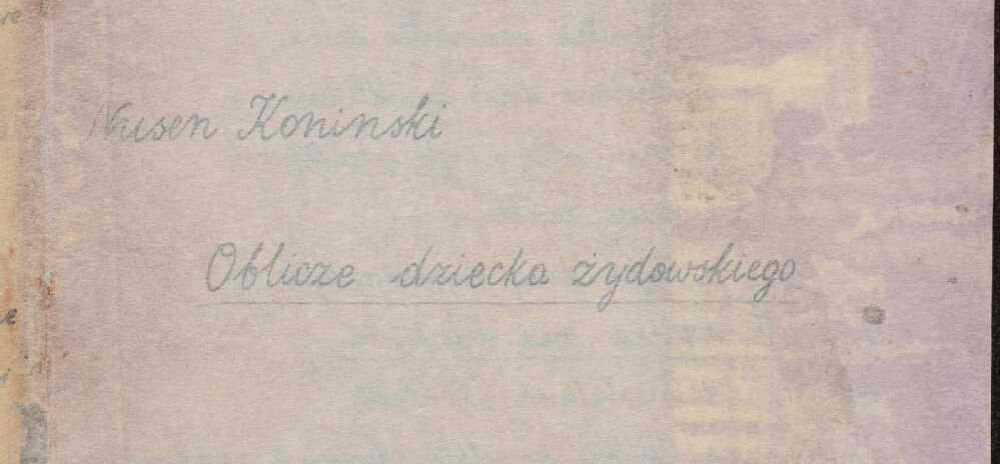- News
- Events
- Oneg Shabbat
- Collections
- Research
- Exhibitions
- Education
- Publishing Department
- Genealogy
- About the Institute
- Bookstore


From the documents preserved in the Archive we learn that Koniński arrived in Warsaw from Kalisz in November 1939, with his mother and younger brother. In the ghetto, they lived at 5/30 Ogrodowa street.
In Oneg Shabbat, he was responsible mainly for copying documents, but he also wrote several reports. In general, 27 pieces of text written by him were preserved. Many of them are signed with a codename „Kon” or „Kohn”. Among his original writings, a particularly interesting one is An account of 1939 by a man from Kalisz, based on his own experiences and written down in 1941. It described life in Kalisz before the war and escape to Warsaw in November 1939.
We escaped in rush and panic, without preparations, feverishly. (…) With my mother and little brother, we had left the house in the morning and went to our friends in order to ask what to do. (…) They were already packed and leaving for the railway station to make it for the train in 20 minutes. Without much thinking, we had left together with them, not coming back to the apartment even to take the most necessary items. [1]
In late November 1939, the author made an attempt to escape to the East. After a few days in Warsaw, I have decided to take this step. I have to admit that I was driven by egotistic purposes. At the time of my departure, I was leaving in Warsaw my mother and six-year old brother – refugees without any belongings or money, and I had no certainty if they could make a living. Despite this, I have followed various instigations and under the influence of many examples, I have decided to travel. My intention was to go to Lviv and enroll into university. [2]
![koniński_1.jpg [123.30 KB]](https://www.jhi.pl/storage/image/core_files/2022/7/28/d4fda8b7c8e01ab6bd18fed7c4f73344/jpg/jhi/preview/koniński_1.jpg)
He describes his travel to Siedlce and a successful attempt to get to the other side of the Bug river. On the Russian side, he was caught by the border patrol and with a group of about 300 other arrested Jews, he was sent back to the border. He writes that for many people, the unsuccessful escape proved „discouraging”, other were trying again later.
One of the most valuable works by Koniński is The Face of the Jewish Child, a report from 1941, in which he described the fates of Jewish children during the occupation: the homeless, the children resettled from other places to the Warsaw Ghetto, crime among minors, ways of earning money and finding food, organizing secret education and social aid. He wrote regretfully: The Jewish child, child of a persecuted nation, has experienced – and still does – shocks which probably no child in other human society has to cope with. (…) In current circumstances, the Jewish child is in danger of complete physical and spiritual degeneration… [3]
After December 1941, Koniński also wrote Give away your furs. The reaction of the people from the Warsaw Ghetto to the order to give up their furs, in which he described the December 1941 order accroding to which the Jews had to give away their fur coats, as well as other coats or fur collars, under the penalty of death.
Each anti-Jewish order has its prehistory in the ghetto. It seems that the ghetto predicts a coming blow. Is seems similar to a snail in terms of sensitivity, with the difference that it can’t hide into a shell and remains helpless. [4]
![koniński_2.jpg [129.94 KB]](https://www.jhi.pl/storage/image/core_files/2022/7/28/ae076d9be2580a2fc28e50a5706b6e5a/jpg/jhi/preview/koniński_2.jpg)
In the Ringelblum Archive, it was possible only to recognize Koniński’s writings in Polish and German, we don’t know whether he was using Yiddish as well. According to the documents from the Archive, he was receiving a small fee from Oneg Shabbat for his work, between 22 January and 9 June 1942.
The circumstances of his death remain unknown.
Written by: Anna Majchrowska
Translated by: Olga Drenda
Footnotes:
[1] The Ringelblum Archive, Tereny wcielone do Rzeczy: Kraj Warty, vol. 9, ed. Magdalena Siek, UW, Warsaw 2012, p.182.
[2] The Ringelblum Archive, Relacje z Kresów, vol. 3, ed. Andrzej Żbikowski, JHI, Warsaw 2000, p. 5.
[3] The Ringelblum Archive, Dzieci – tajne nauczanie w getcie warszawskim, vol. 2, ed. Ruta Sakowska, JHI, Warsaw 2000, p. 359-377.
[4] The Ringelblum Archive, Getto warszawskie. Życie codzienne, vol. 5, ed. Katarzyna Person, JHI, Warsaw 2011, p.471.
Bibliography:
The Ringelblum Archive, Dzieci – tajne nauczanie w getcie warszawskim, vol. 2, ed. Ruta Sakowska, JHI, Warsaw 2000.
The Ringelblum Archive, Relacje z Kresów, vol. 3, ed. Andrzej Żbikowski, JHI, Warsaw 2000.
The Ringelblum Archive, Getto warszawskie. Życie codzienne, vol. 5, ed. Katarzyna Person, JHI, Warsaw 2011.
The Ringelblum Archive, Tereny wcielone do Rzeczy: Kraj Warty, vol. 9, ed. Magdalena Siek, UW, Warsaw 2012.